
Lajas is a town and municipality of Puerto Rico located in the Lajas Valley in southwestern Puerto Rico, on the southern coast of the island, bordering the Caribbean Sea, south of San Germán and Sabana Grande; east of Cabo Rojo; and west of Guánica. Lajas is spread over 11 barrios plus Lajas Pueblo. It is part of the San Germán-Cabo Rojo Metropolitan Statistical Area.

Yabucoa is a town and municipality in Puerto Rico located in the eastern region, north of Maunabo; south of San Lorenzo, Las Piedras and Humacao; and east of Patillas. Yabucoa is spread over 9 barrios and Yabucoa Pueblo. It is part of the San Juan-Caguas-Guaynabo Metropolitan Statistical Area.

Cabo Rojo is a city and municipality situated on the southwest coast of Puerto Rico and forms part of the San Germán–Cabo Rojo metropolitan area as well as the larger Mayagüez–San Germán–Cabo Rojo Combined Statistical Area.

Guánica is a town and municipality in southwestern Puerto Rico, bordering the Caribbean Sea, south of Sabana Grande, east of Lajas, and west of Yauco. It is part of the Yauco metropolitan statistical area.
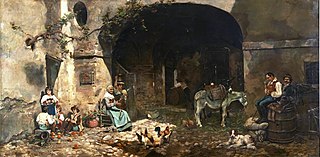
A parador, in Spain and other Spanish-speaking countries was an establishment where travelers could seek lodging, and usually, food and drink, similar to an inn. In Spain since 1928, a Parador is a state-owned luxury hotel, usually located in a converted historic building such as a monastery or castle, or in a modern building in a nature area with a special appeal or with a panoramic view of a historic and monumental city.

Puerto Rico Highway 116 (PR-116) is a main highway in the southwest part of Puerto Rico, beginning in Guánica, Puerto Rico at Puerto Rico Highway 2 to Lajas, Puerto Rico at Puerto Rico Highway 101.

Boquerón is a barrio in the municipality of Cabo Rojo, Puerto Rico. Its population in 2010 was 5,373. The village of Boquerón, located on the Boquerón Bay is one of the main tourist attractions in the southwestern part of the island. In 2000, its population was 4,963.
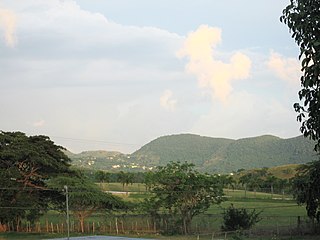
The Lajas Valley, or the Yauco-Boquerón Valley, is an anticlinal valley that runs 30 km long and 5 km wide east-to-west in southwestern Puerto Rico, within the municipalities of Lajas, Cabo Rojo, Guánica, and Sabana Grande. It is surrounded by the Cordillera Central and the Santa Marta hills to the north, the Sierra Bermeja to the south, the Boqueron Bay in Cabo Rojo to the west, and the Guánica Bay and southern karst to the east. The climate is considered moist to dry subhumid tropical. Its large extension and fertile soil have made it a good place for agriculture. However, it is one of the driest places of Puerto Rico, making irrigation necessary.
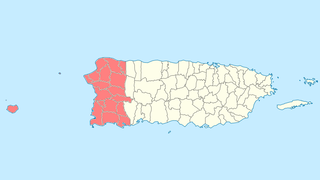
Porta del Sol is a tourism region in western Puerto Rico. It consists of 17 municipalities in the western area: Quebradillas, Isabela, San Sebastián, Moca, Aguadilla, Aguada, Rincón, Añasco, Mayagüez, Las Marías, Maricao, Hormigueros, San Germán, Sábana Grande, Guánica, Lajas and Cabo Rojo. Porta del Sol was established in 2003 by the Puerto Rico Tourism Company. The name translates to "Doorway to the Sun"

Puerto Rico Highway 101 (PR-101) is a rural road leaving the town of Boquerón, Cabo Rojo and Lajas, to the town of San Germán. Among their intersections are the PR-100, PR-301, PR-103 PR-116, PR-166 and PR-102.
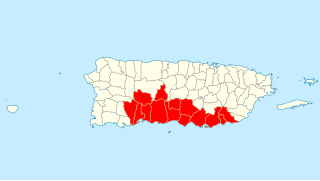
Porta Caribe is a tourism region in southern Puerto Rico. It was established in 2003 by the Puerto Rico Tourism Company, an agency of the Government of Puerto Rico. When created in 2003 it consisted of 14 municipalities in the south central zone. With the creation of the neighboring Porta Cordillera zone in July 2012, the municipalities of Adjuntas and Jayuya were transferred to the newly created Porta Cordillera zone and Porta Caribe became a 12-municipality tourism region. The name Porta Caribe translates to "Doorway to the Caribbean." Its executive director is Maritza W. Ruiz Cabán.

Sierra Bermeja is a mountain range in southwestern Puerto Rico. It forms the southern boundary of the Lajas Valley and it is bordered by La Parguera in the Caribbean Sea coast. It extends from the municipality of Cabo Rojo in the west to Lajas in the east. It consists of a combination of volcanic rocks, completely crossed by serpentinite and amphibolite faults, which could well be the oldest known rock in Puerto Rico. The mountains were used by the Taíno people as refuge from the Spanish, and then by smugglers during the Spanish colonization.
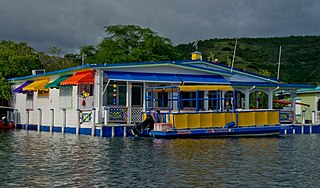
Parguera is a barrio in the municipality of Lajas, Puerto Rico with a population of 2,082 in 2010. La Parguera is the main settlement of the barrio, often referred to as Poblado de la Parguera. Parguera is home to La Parguera Nature Reserve, which encompasses the bioluminescent bay, its surrounding mangrove forests, wetlands and a number of keys such as Mata La Gata and Cayo Enrique. The name Parguera derives from pargo, the local name for the Northern red snapper.

Boquerón State Forest is one of the 20 forestry units that make up the public forest system of Puerto Rico. Despite its name, the Boquerón State Forest is not only located in Boquerón, Cabo Rojo but also spans almost 5,000 acres across the municipalities of Cabo Rojo, Lajas and Mayagüez. The forest area is also known for its limestone cliffs, the lighthouse, and the salt flats which have been a source of salt since the pre-Hispanic era and, dating to 700 C.E., they are considered to be one of the oldest industries in the Americas.
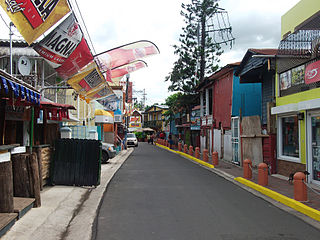
El Poblado de Boquerón is a coastal village which represents the downtown or main urban nucleus of the barrio (district) Boquerón of Cabo Rojo, located on the northeast of Boquerón Bay. The village is a major tourist destination, and it is renown in Puerto Rico for its gastronomy, boathouses, beach, nightlife and its yearly pride parade.

Julio Enrique Pancorbo Ortiz, better known as Henry LaFont, was a Puerto Rican lawyer, businessman, television comedian and tourism official.


















